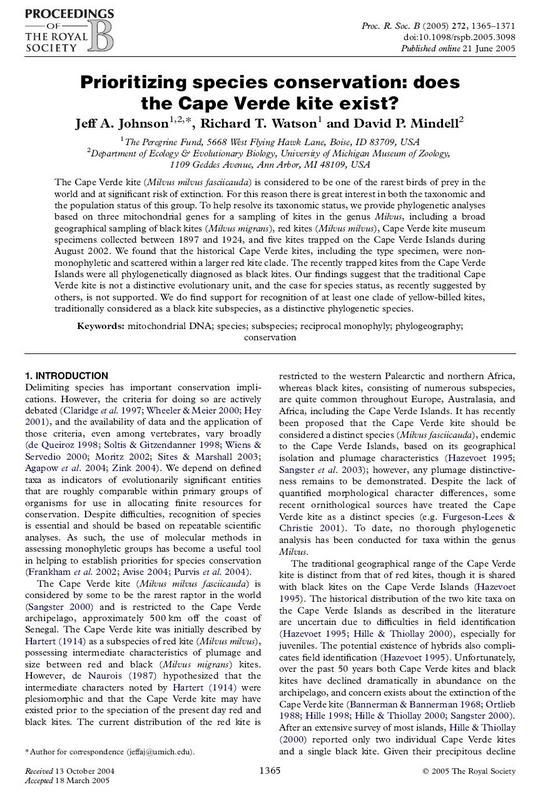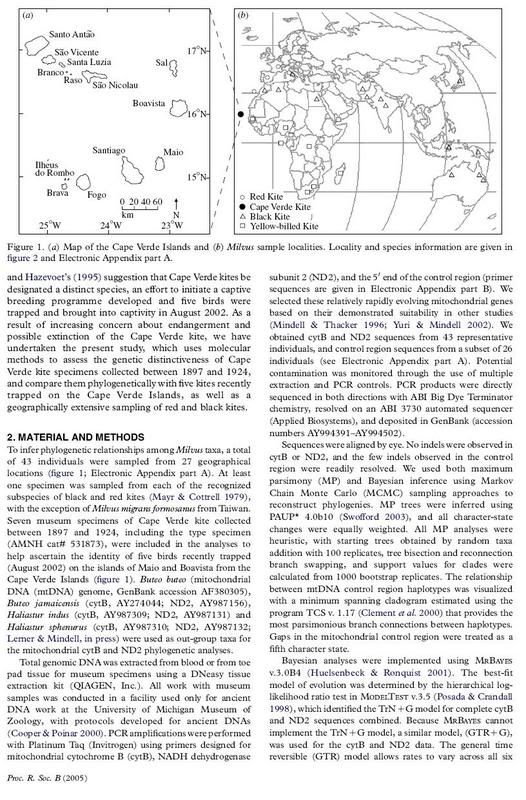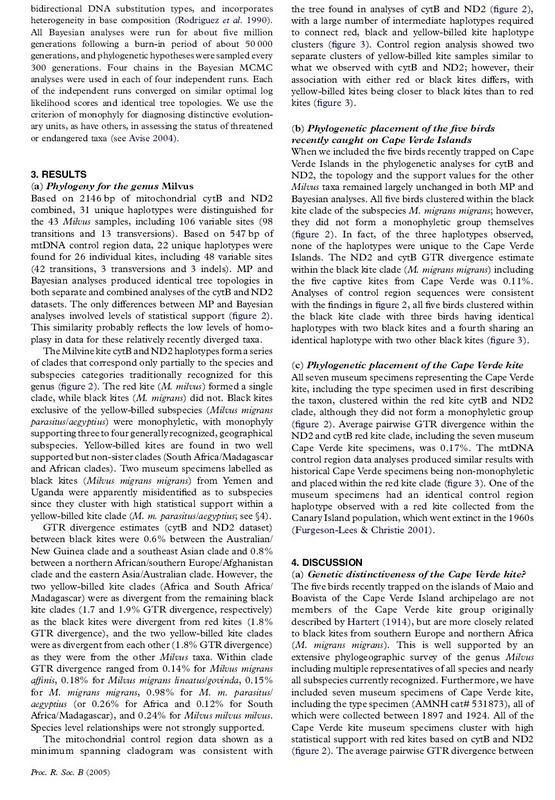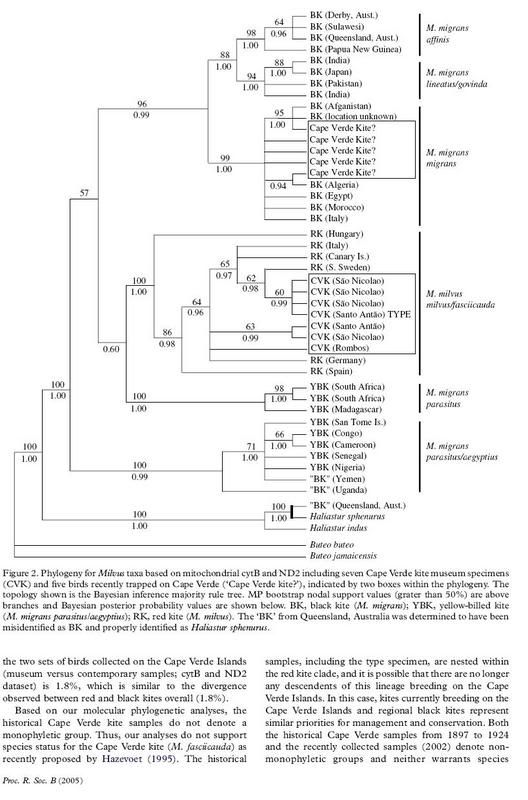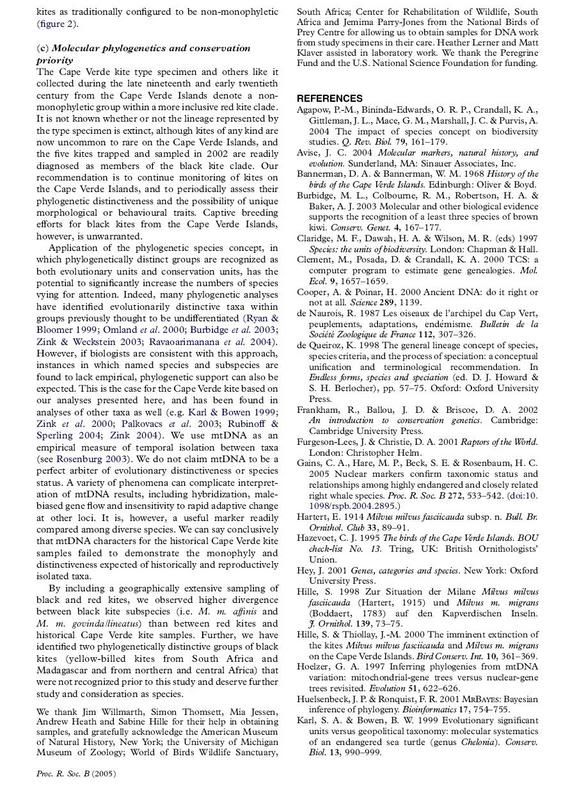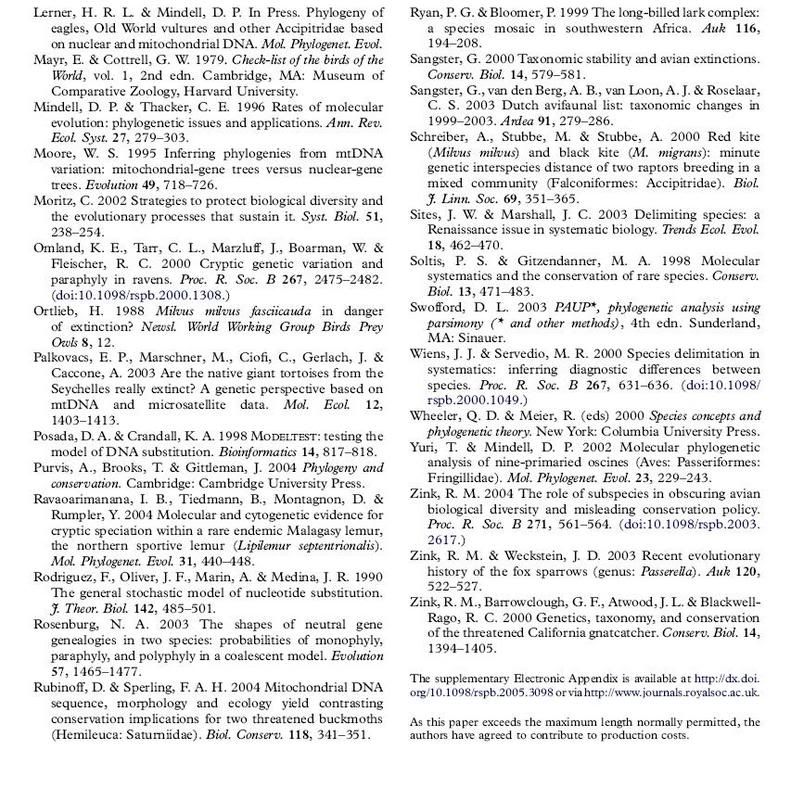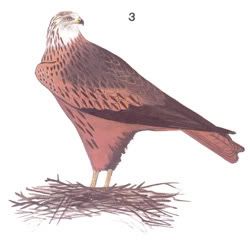|
|
Post by dysmorodrepanis on Jun 28, 2005 14:18:00 GMT
Milvus fasciicauda, the Cape Verde Kite, was considered a subspecies of the Red Kite Milvus milvus until 1995 (C.J. Hazevoet, The Birds of the Cape Verde Islands. B.O.U. Check-list 13, 1995). In 1998, only 4 old birds remained, together with 2 probable hybrids with the Black Kite Milvus migrans, on the island of Santo Antão. No breeding attempts were observed. (Hille, S. (1998): Situation of the Kites Milvus milvus fasciicauda and Milvus m. migrans on the Cape Verde Islands.- J. Orn. 139: 73-75.) In 1999, two of the remaining birds were not found anymore. (Hille, S. & Thiollay, J. M. (2000): The imminent extinction of the Kites milvus milvus fasciicauda and Milvus m. migrans on the Cape Verde Islands . Bird Conservation International 10: 361-369) abstract here: www.cambridge.org:80/uk/journals/journal_article.asp?mnemonic=BCI&pii=S0959270900000319What probably was the remaining 2 birds seen in March 2000 on neigboring island São Vicente (where extinct since the late 20th century): www.birdquest.co.uk/frameset.cfm - see Trip Reports, The Cape Verde Islands, 2000. These birds have not been found anymore since 2000. 6 birds which are either Cape Verde kite, Black Kite or hybrids were found on Boa Vista and Maio islands in 2001. 5 of them were captured and DNA-tped, but it seems they have not been confirmed to be fasciicauda (no follow-ups found online), which anyway never was recorded from these islands (though the Maio records might represent this bird, as it still occurred on neigboring Santiago in the early 1990s). www.doftravel.dk/reports/capeverd.pdfAs this bird was believed a subspecies of Milvus milvus and subspecies are not afforded legal protection, it was allowed to decline (along with the local population of Milvus migrans, which is not distinct). Much of the decline of this species is summed up here: George Sangster, Taxonomic Stability and Avian Extinctions. Conservation Biology 14:579 (2000)
|
|
|
|
Post by sebbe67 on Jun 28, 2005 14:34:52 GMT
yes indeed, I had posted a thread about this bird before, I deleted it as the bird still survive.
|
|
|
|
Post by dysmorodrepanis on Jun 28, 2005 14:49:34 GMT
|
|
|
|
Post by another specialist on Jul 23, 2005 9:38:39 GMT
inform us if you find anything else new about this species
|
|
|
|
Post by dysmorodrepanis on Jul 23, 2005 13:52:48 GMT
I've checked out the paper and I find it somewhat lacking. Fasciicauda group molecularly in the Red Kite in 1 nice clade (n=4), 1 distinct one (n=2) and one single specimen, which argues against special status (species or even subspecies). But the specimens form distinct clades, and hypotheses of genetic introgression have not been much explored. That hybridization is possible is shown by the disappearance of this form due to hybridization with the Black Kite. So all that can be said is that all researched specimens of fasciicauda have some Red Kite from a specific population in their ancestry.
Fasciicauda was a very distinct form (check HBW for illustration). So it was genetically different without doubt, but then again, it was nothing special as far as the 2 sequences treated in the paper go.
It is a complete mystery, and the present paper opens more questions than it solves (notably, how can a bird that is molecularly so similar can be phenotypically so different?)
At any rate, it illustrates the problems with species concepts. Fasciicauda seems to hold a place in evolution similar to the Red Wolf. It is probably a good phylogenetic species (i.e., one that has started its own evolutionary lineage) due to the fact that it was at least a distinct sub-population (sequences mostly group together inside M. milvus) - note that the molecular biogeography of M. milvus is very confusing; most fasciicauda specimens are most closely related to a Red Kite specimen from Sweden (among those researched) according to sequence data!
It is not a biological species (i.e., one that has already completed speciation).
However, alternative explanations (genetic introgression, revertant mutations etc) are not thoroughly explored given the fact that visually, this form is as distinct as to be judged a species from appearance alone. If you have seen the Acrocephalus orinus re-evaluation, that's how a thorough molecular phylogenetic analysis should be done: all possible alternative hypostheses are argued and refuted.
At any rate, the paper strongly suggests that Milvus migrans parasitus and aegyptius are a distinct species (Yellow-billed Kite). But its phylogeny illustrates very well the drawbacks: one can only see the differences in molecular analyses, but neither a) when these occurred and b) what differences have already been obliterated by subsequent revertant and/or parallel mutation (if a base mutates e.g. C->G->C, it seems as if no mutation has taken place; if it goes C->G->A in one lineage and C->T->A in another, it seems as if these lineages were closer related than they actually are) - as opposed to phenotypical synapomorphies (independently acquired derived characters), molecular synapomorphies cannot be detected. So in the Yellow-billed kite, the SE African lineage (parasitus) is from sequence data alone closer related to M. milvus than to M. migrans, but the C Africa (aegyptius) lineage is a sister group to both! The only difference in molecular phylogeny, in fact, between the YBK (in comparison to all Milvus kites) and fasciicauda (in comparison to M. milvus), is the presence of some M. milvus outliers settled around the milvus/fasciicauda group.
I'd advocate against specific status as of now, but I'm not convinced that it is (was) not a distinct subspecies, a rather young one which was subject to a strong founder effect (rapid evolution of distinct phenotype) and several episodes of genetic introgression (molecular and morphological phylogeny don't match). Both phenomena are rather common in speciation events on oceanic islands which are within easy reach of potential founder populations on the continent or stepping-stone islands (the Canaries, in this case).
All that can be said is that fasciicauda was very closely related to M. milvus, and that it is extinct.
The phylogeny of fasciicauda could, for example, be adequately explained if it were in fact derived from 'early' milvus (soon after the milvus-migrans-YBK split) and if 2 (one early, one late) colonization and hybridization events with female milvus had happened.
The drawback with mtDNA analyses is that hybridization events in such island populations mess up the phylogeny. Nuclear DNA sequences of the specimens could hint on whether this pyhlogeny is an artifact or genuine.
Maybe I sound too harsh on this paper, but explicitly drawing conservation recommendations from nothing but molecular phylogeny (what about biogeography? what about the phenotype?) is sloppy science IMHO: 'oh, the Cape Verde kites are nothing special, so they don't need conservation action' is what made kites disappear from those islands in the first place...
(Melanie: can you change the topic to: Milvus milvus 'fasciicauda' plz?)
|
|
|
|
Post by another specialist on Jul 24, 2005 6:38:17 GMT
thanks for the information very interesting a good read
|
|
|
|
Post by another specialist on Jul 31, 2007 21:52:28 GMT
So does this species / subspecies still survives? or our they hybrids?
if so really this should be moved back to extinct.
|
|
|
|
Post by sebbe67 on Jul 31, 2007 23:01:58 GMT
So does this species / subspecies still survives? or our they hybrids? if so really this should be moved back to extinct. No it shouldent be moved to extinct. The identity of this bird still remains disputed some argue that its a hybrid with Black kite, other classify it as a subspecies of Red Kite while others classify it as a seperate species. There is however several recent records from the Cape Verde Islands Birds of the Atlantic Islands |
|
|
|
Post by another specialist on Jul 31, 2007 23:32:45 GMT
There is however several recent records from the Cape Verde Islands
But are those hybrids or true Milvus milvus fasciicauda - Cape Verde Kite
That is the question .
Seeing a kite does make it a true pure bred Cape Verde Kite
|
|
|
|
Post by another specialist on Jul 31, 2007 23:37:26 GMT
dysmorodrepanis says All that can be said is that fasciicauda was very closely related to M. milvus, and that it is extinct.
So if the recent sightings can't be proved to be purebred Milvus milvus fasciicauda - Cape Verde Kite not hybrids then it should be moved to extinct.
Currently there is no confirmation or sightings that gaurantee purebreeds and not crossbreeds/hybrids.
|
|
|
|
Post by sebbe67 on Aug 1, 2007 0:04:27 GMT
dysmorodrepanis says All that can be said is that fasciicauda was very closely related to M. milvus, and that it is extinct. So if the recent sightings can't be proved to be purebred Milvus milvus fasciicauda - Cape Verde Kite not hybrids then it should be moved to extinct. Currently there is no confirmation or sightings that gaurantee purebreeds and not crossbreeds/hybrids. dysmorodrepanis summarise (which is very good and includes alot of info) is over two years old and new info has become avaible since. As long as the remaning birds isnt studied in detail no one knows whatever they are pure or hybrids, it should remain here as long as no ones manages to prove that whatever its hybrid birds or pure ones. |
|
|
|
Post by another specialist on Aug 1, 2007 6:53:30 GMT
You say more recent studies and info is available can you provide this information or sources that you refer to. To prove otherwise what dysmorodrepanis is old and out of date.
|
|
|
|
Post by sebbe67 on Aug 1, 2007 7:30:59 GMT
Field Guide to the Birds of the Atlantic Islands: Canary Islands, Madeira, Azores, Cape Verde written by Tony Clarke which probably is the foremost expert on birds of this region.
|
|
|
|
Post by another specialist on Aug 1, 2007 9:02:26 GMT
Field Guide to the Birds of the Atlantic Islands: Canary Islands, Madeira, Azores, Cape Verde written by Tony Clarke which probably is the foremost expert on birds of this region. And what does this book say exactly. |
|
|
|
Post by another specialist on Aug 1, 2007 15:26:25 GMT
|
|
|
|
Post by another specialist on Aug 1, 2007 15:28:29 GMT
|
|
|
|
Post by another specialist on Aug 1, 2007 15:29:12 GMT
|
|
|
|
Post by another specialist on Aug 1, 2007 15:35:16 GMT
|
|
|
|
Post by another specialist on Aug 2, 2007 7:45:41 GMT
Field Guide to the Birds of the Atlantic Islands: Canary Islands, Madeira, Azores, Cape Verde written by Tony Clarke which probably is the foremost expert on birds of this region. And what does this book say exactly. Can you provide info from this book that states any new sightings and confirms not hybrids plus any further DNA sampling that is more recent. |
|
|
|
Post by sebbe67 on Aug 2, 2007 10:05:48 GMT
And what does this book say exactly. Can you provide info from this book that states any new sightings and confirms not hybrids plus any further DNA sampling that is more recent. No I cant do that now as aim on a conferance in Bangkok and the book is back home. |
|



